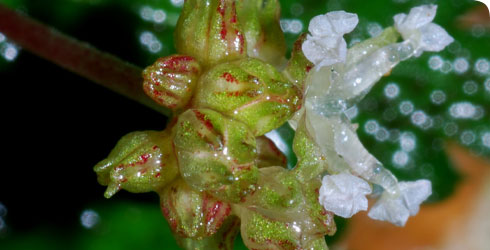Biology
Pilea matama is a perennial herb with a creeping stem from which erect or semi-erect branches grow up to 25cm long.
It grows on the ground close to water or as an epiphyte low down on the trunks of trees and saplings.
Its leaves are very striking:
- they are borne in unequal pairs
- the major leaf in each pair is long and narrow with a profoundly divided margin that resembles a fern frond
- the minor leaf in each pair is much shorter but also deeply divided
The flower clusters are tiny - 1.5–20mm, and only bear flowers of one sex.
Male flower clusters are the larger - up to 20mm long - and bear 5 to 39 pale green flowers that are about 2.5mm in length.
The flowers open explosively releasing small clouds of pollen.
The female clusters range from 1.5–6mm in length, bearing 3–16 flowers in a compact head.
The female flowers are minute - 0.75–1mm. They are pale green and have a tiny tuft of hairs at their tip that serves to trap pollen.
The fruit consists of a single pale brown ellipse-shaped disk about 2mm in length.
Reproduction
Little is known about the biology of this species. It sets abundant seed, but we don’t know whether the plants are self-compatible or require fertilisation by another plant.
The plant is probably wind-pollinated like most members of this family.
The explosive opening of the male flowers is believed to be triggered by the drying-out of the flower. Plant handling also triggers the explosive opening. This suggests animal-mediated pollination may occur.
Dispersal
The fruits consist of a naked seed, devoid of any hooks or sticky glands that might aid dispersal.
The seed is ejected from the plant by the erection of structures known as ‘staminodes’.
The seeds are ejected only a few millimetres and it is unclear how the species is able to spread. This may account for its very narrow distribution.
Toolbox
Glossary
Epiphyte
A plant that grows on another plant, but not parasitically.
Staminodes
A stamen that does not produce pollen.
